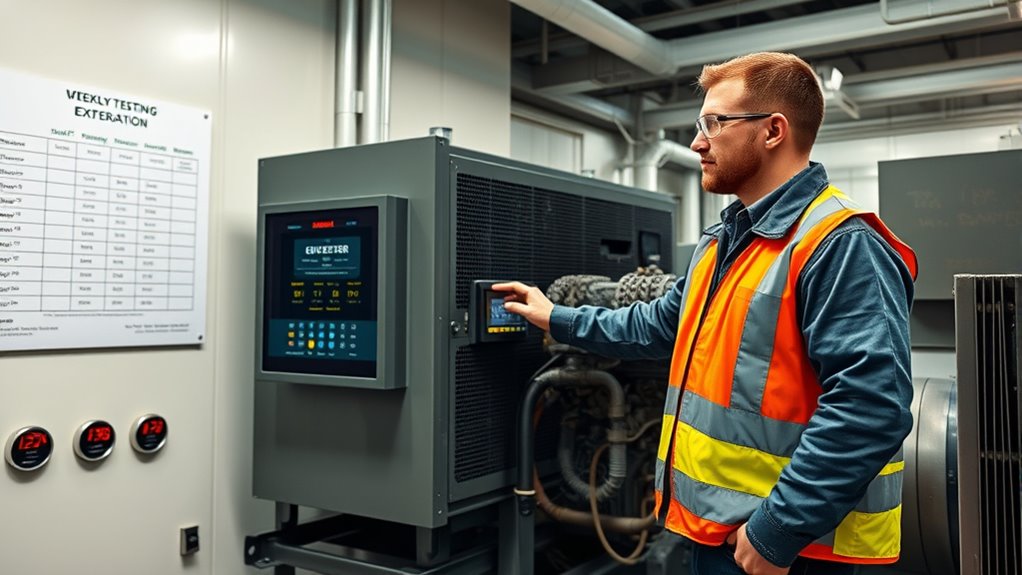To run weekly generator exercise tests, start by preparing the area—clear debris and wear safety gear. Turn on the generator, monitor gauges closely, listen for unusual noises, and check for proper operation of the transfer switch. Keep detailed logs of each test, noting any irregularities. Follow safety protocols and shut down properly after testing. Staying consistent and thorough guarantees your generator stays ready—continue exploring if you want to master every step.
Key Takeaways
- Prepare the area by clearing debris and ensuring safety gear is worn before starting the test.
- Start the generator gradually, monitoring gauges and listening for abnormal sounds or vibrations.
- Verify proper operation of transfer switches and the power supply to designated loads during the exercise.
- Observe exhaust emissions and check for warning lights or alerts throughout the test.
- Document the test results, including any irregularities or maintenance needs, and follow proper shutdown procedures.

Regular weekly generator exercise tests are essential to guarantee your backup power system operates reliably when you need it most. Performing these tests regularly allows you to identify potential issues early, ensuring your generator will perform effectively during an outage. To do this properly, you need to follow specific maintenance procedures that keep your equipment in top condition. Regularly inspecting the generator’s oil levels, coolant, and fuel supply is critical. Check for leaks, corrosion, or wear on belts and hoses. Keeping a detailed maintenance log helps you track what has been done and when, so you can stay on top of scheduled maintenance and avoid unexpected breakdowns. Incorporating predictive analytics can help forecast potential failures before they occur, further enhancing your maintenance strategy.
Safety precautions are equally important when running weekly tests. Before starting, ensure the area around your generator is clear of debris and obstacles, reducing the risk of accidents. Always wear appropriate personal protective equipment, such as gloves and safety glasses, to safeguard against moving parts or accidental spills. Make sure you understand the generator’s emergency shut-off procedures and keep accessible instructions nearby. Never attempt to perform testing or maintenance while the generator is running if you’re not trained or authorized to do so. Always disconnect the power source if needed and follow lockout/tagout procedures to prevent accidental activation.
When you start your weekly exercise, do so in a controlled manner, monitoring the system closely. Listen for unusual noises, vibrations, or excessive exhaust smoke, which could indicate problems. Keep an eye on the gauges and warning lights, ensuring the engine reaches proper operating temperatures and oil pressure stabilizes within normal ranges. During the test, verify that the generator supplies power to your designated loads and that automatic transfer switches operate correctly if installed. Once the test concludes, shut down the generator following the proper procedures, allowing it to cool before performing any post-test inspections.
It’s also wise to document each test, noting any irregularities, maintenance performed, and parts replaced. This record helps you anticipate future needs and maintain compliance with safety standards. Remember, neglecting maintenance procedures or ignoring safety precautions can lead to costly repairs or dangerous accidents. By sticking to a consistent weekly testing schedule, adhering to proper maintenance routines, and observing safety precautions, you can ensure your backup power system remains ready and reliable whenever you need it. Consistency and cautious approach make all the difference in keeping your generator operational and safe for everyone involved.
Frequently Asked Questions
What Safety Precautions Should Be Taken During Tests?
You step into the generator’s domain, where safety is your shield. Wear protective gear like gloves and goggles, and guarantee test equipment is in perfect condition. Keep a fire extinguisher nearby and clear the area of obstructions, like guards on a fortress. Stay alert and never bypass safety protocols, because generator safety depends on your vigilance. When you test, you’re the guardian—protect yourself and the equipment with unwavering caution.
How to Document Generator Test Results Effectively?
You should keep detailed testing documentation by recording all test results, including start and end times, performance metrics, and any issues encountered. Use clear, consistent formats to track maintenance scheduling and test outcomes, making future reviews easier. Regularly update logs immediately after each test, ensuring accuracy. This thorough documentation helps identify trends, plan maintenance, and verify generator reliability over time.
What Are Common Signs of Generator Issues During Testing?
Think of your generator as a trusty steed; if it starts sputtering or hesitating during the test procedure, it’s a sign of trouble. Common issues include unusual noises, excessive vibrations, or warning alarms. During weekly generator maintenance, watch for difficulty starting, loss of power, or smoke. These signs indicate the need for immediate inspection and possibly more detailed diagnostics to guarantee reliable operation when you need it most.
How to Troubleshoot if the Generator Fails to Start?
If your generator fails to start, first check the fuel maintenance to make certain there’s enough clean fuel and no blockages. Verify the battery charge and connections, as poor connections can prevent starting. Conduct a load testing to see if the generator can handle operational demands. If issues persist, inspect the control panel and starter components for faults, and perform routine maintenance to keep everything functioning properly.
Are There Specific Testing Intervals for Different Generator Types?
Think of generator maintenance like tuning a fine instrument—you need regular checks to keep it in harmony. Testing intervals vary by generator type; small units might need monthly tests, while large standby generators often follow quarterly or semi-annual testing protocols. Always consult manufacturer guidelines and industry standards to make certain your testing schedule aligns with best practices, preventing surprises and keeping your power backup ready when you need it most.
Conclusion
Running weekly generator exercise tests keeps your system reliable, keeps your team prepared, and keeps your facility compliant. Consistency ensures trust, accountability, and peace of mind. When you prioritize these tests, you prevent surprises, promote safety, and protect your operations. Make testing part of your routine, part of your safety culture, part of your success. Because when you commit to regular testing, you commit to continuous improvement, to unwavering readiness, and to safeguarding what matters most.









